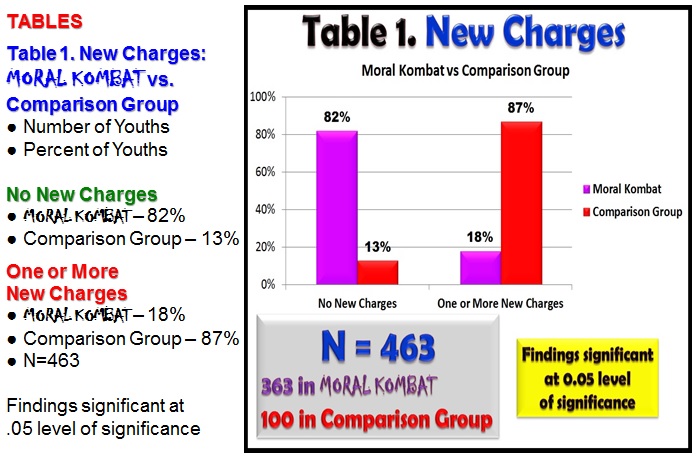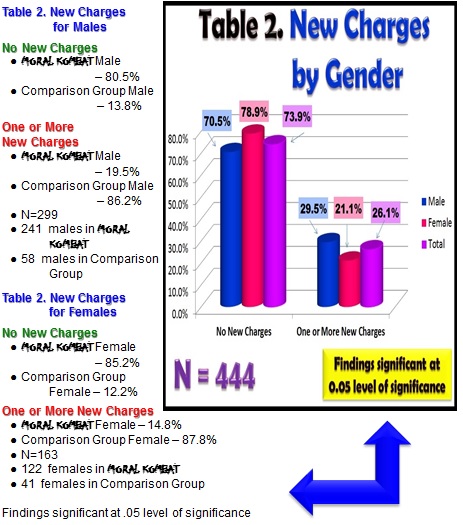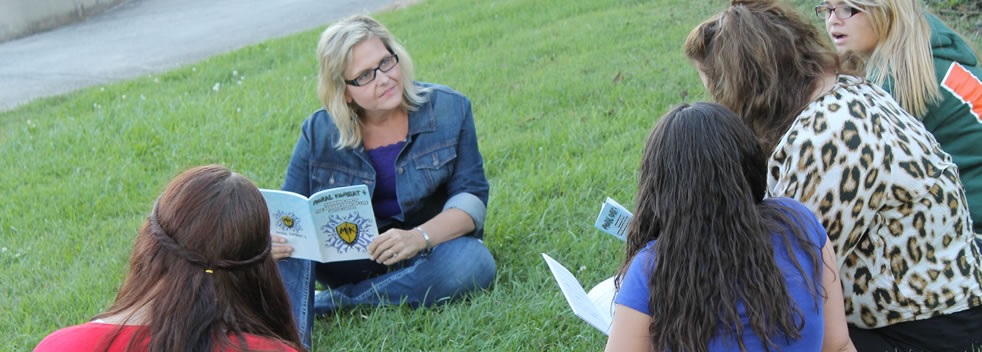Report on  Program
Program
September 25, 2008
John T. Whitehead, Ph.D. & Steven Ellwanger, Ph.D.
Dept. of Criminal Justice & Criminology
East Tennessee State University
Report on 
Fall, 2008
Introduction
![]() is an ethics based restorative justice program run by Foundations for Life Principles. Initially, the program focused on character education and ethical behavior training for older, troubled, at-risk youth. The program consists of six 2-hour sessions about universally accepted values and ethical decision making skills.
is an ethics based restorative justice program run by Foundations for Life Principles. Initially, the program focused on character education and ethical behavior training for older, troubled, at-risk youth. The program consists of six 2-hour sessions about universally accepted values and ethical decision making skills.
More recently, ![]() has expanded to include training in parenting, emotion control, life skills, dealing with drug and alcohol abuse, and a program to combat theft, shoplifting, and bad check writing. It has also expanded to include adults as well as adolescents.
has expanded to include training in parenting, emotion control, life skills, dealing with drug and alcohol abuse, and a program to combat theft, shoplifting, and bad check writing. It has also expanded to include adults as well as adolescents.
Current Evaluation
Data was collected on over 450 youths: those who completed the ![]() program from late Fall, 2005 through late Fall, 2006 and a comparison group.
program from late Fall, 2005 through late Fall, 2006 and a comparison group.
The sample of 463 youths was 65 percent male and 35 percent female. Most of the youths (88 percent) were white; 9 percent were black, and 2 percent were Hispanic or other racial category. Three hundred sixty-three youths (363) completed ![]() . One hundred youths (100) were in the comparison group.
. One hundred youths (100) were in the comparison group.
Concerning what type of offenses the youths who recidivated committed, according to court records, most youths (67%) did not commit a new offense; 7.6 percent committed a violent offense; about 6 percent committed a property offense; and another 6 percent committed a status offense; 2 percent committed a drug offense; and there were 11 percent in the residual, other category.
However, a sample size of over 400 youths does allow us to place considerable confidence in the findings. It also allows for some breakdowns such as comparing male and female youths who participated in the ![]() program.
program.
Overall, the vast majority of youths who received and completed ![]() training did very well. Specifically, 82 percent of the youths who completed the program succeeded; in other words, they did not commit a new offense. Conversely, less than one quarter (18 percent) of the youths who completed
training did very well. Specifically, 82 percent of the youths who completed the program succeeded; in other words, they did not commit a new offense. Conversely, less than one quarter (18 percent) of the youths who completed ![]() failed by committing a new offense. (See Table 1.)
failed by committing a new offense. (See Table 1.)
The comparison group performed almost exactly opposite. Eighty-seven percent (87%) of this group did recidivate; in other words, they committed a new offense. Only 13 percent of the comparison group youths were crime free.
We also looked at the relationship of gender to success. Gender did not affect the outcomes. Specifically, 80.5 percent of the males and 85 percent of the females who went through ![]() succeeded; in other words, they avoided new offenses. Conversely, 86 percent of the comparison group males and 88 percent of the comparison group females committed new offenses.
succeeded; in other words, they avoided new offenses. Conversely, 86 percent of the comparison group males and 88 percent of the comparison group females committed new offenses.
A question that jumps out from the pages of this report is: Why did the ![]() youth do so well compared to the comparison group? A Senior Probation Officer whose job it was to monitor the youths attributes the success of
youth do so well compared to the comparison group? A Senior Probation Officer whose job it was to monitor the youths attributes the success of ![]() to the fact that
to the fact that ![]() has pre-attendance contact with the youth and his/her family, a mentoring component with 24-hour support, contact with the court about youth who miss classes, and the incorporation of (REBT) Rational Emotive Behavioral Therapy. There is also the possibility that many of the programs serving the comparison group youth are either delivering out-of-date treatment services or are not delivering much in the way of services.
has pre-attendance contact with the youth and his/her family, a mentoring component with 24-hour support, contact with the court about youth who miss classes, and the incorporation of (REBT) Rational Emotive Behavioral Therapy. There is also the possibility that many of the programs serving the comparison group youth are either delivering out-of-date treatment services or are not delivering much in the way of services.
A second factor that contributed to the high success rate is that our data did not include those youths who did not complete the ![]() program. Program officials inform us that about 10 percent of the youths who start in
program. Program officials inform us that about 10 percent of the youths who start in ![]() do not finish the program. If we factor in a non-completion rate of 10 percent, that would mean that for every 100 youths who start
do not finish the program. If we factor in a non-completion rate of 10 percent, that would mean that for every 100 youths who start ![]() , 10 do not finish, about 74 finish and do not commit a new offense, and 16 finish but commit a new offense.
, 10 do not finish, about 74 finish and do not commit a new offense, and 16 finish but commit a new offense.
If you consider the non-completers and the recidivists as failures, that translates to a failure rate of approximately 26 percent and a success rate of 74 percent. This lower success rate which includes non-completers is still considerably higher than the 13 percent success rate of the comparison group.
The major limitation of this study is that it used a comparison group rather than a randomly assigned control group. Despite this limitation, the success of ![]() is impressive. Over 80 percent of youths who complete
is impressive. Over 80 percent of youths who complete ![]() succeed. Less than 20% commit a new offense.
succeed. Less than 20% commit a new offense.
The results for the comparison group youth were approximately polar opposite: 87 percent of the non-![]() youths committed a new offense. Only 13 percent of those youths were successful.
youths committed a new offense. Only 13 percent of those youths were successful.
Results of a limited multivariate analysis failed to show any significant effects for race or gender. The only significant correlate of success was whether or not the youth had gone through ![]() . This analysis found that the odds of not committing a new crime were over 30 times greater for those who completed
. This analysis found that the odds of not committing a new crime were over 30 times greater for those who completed ![]() compared to those in the comparison group.
compared to those in the comparison group.
A Caution
To offer a caution, Nancy Rodriguez (2005) evaluated a restorative justice program for juveniles in Arizona. The program used a family group conferencing model in which victims, family members, and members of the community met to try to come up with appropriate resolutions. Recidivism was measured for a 24 month follow-up period.
Quite similar to the findings for ![]() in this report, the youths who went through the restorative justice program in Maricopa County, Arizona, did quite well: over 70 percent (71.7%) succeeded; in other words, they did not get formally petitioned to juvenile court. But there was no significant difference between these youths that completed the restorative justice program and youths who went through regular diversion programs instead. Specifically, 68.8 percent of the control group youths also succeeded in avoiding new petitions.
in this report, the youths who went through the restorative justice program in Maricopa County, Arizona, did quite well: over 70 percent (71.7%) succeeded; in other words, they did not get formally petitioned to juvenile court. But there was no significant difference between these youths that completed the restorative justice program and youths who went through regular diversion programs instead. Specifically, 68.8 percent of the control group youths also succeeded in avoiding new petitions.
If Rodriguez had not included a control group, she would have a high success rate (over 70 percent) for the youths in the new restorative justice program. So, her findings would be quite similar to what happened with the ![]() youths in this report. The overwhelming majority, (over 70 percent), succeeded. But the inclusion of a control group shows that the new program was not in fact better than the regular programs in Arizona at the time.
youths in this report. The overwhelming majority, (over 70 percent), succeeded. But the inclusion of a control group shows that the new program was not in fact better than the regular programs in Arizona at the time.
A program for shoplifters in Michigan found that only 10 percent of the treatment group committed a new offense versus 25 percent of the control group. The program included such components as community service, restitution to charities, and apology letters. So this program was 90 percent successful compared to a success rate of 75 percent for the control group.
The success of ![]() , the restorative justice program, and the regular diversion program in Arizona, and both the treatment and the control group in the Michigan study, suggest another factor that may be at work. The treatment effectiveness literature notes that high- and medium-risk youth are most in need of intervention. Low risk youth should not be included. So risk is a factor that might merit more attention in any future evaluations of
, the restorative justice program, and the regular diversion program in Arizona, and both the treatment and the control group in the Michigan study, suggest another factor that may be at work. The treatment effectiveness literature notes that high- and medium-risk youth are most in need of intervention. Low risk youth should not be included. So risk is a factor that might merit more attention in any future evaluations of ![]() .
.
In this evaluation, ![]() did include a comparison group and that group did much worse than the
did include a comparison group and that group did much worse than the ![]() youths. To repeat, 87 percent failed. Unless somehow, the courts selected children who were much more likely to succeed (perhaps youths with more effective parents, fewer school problems, youths with higher IQ scores, youths with fewer mental & emotional problems), the dramatic differences between
youths. To repeat, 87 percent failed. Unless somehow, the courts selected children who were much more likely to succeed (perhaps youths with more effective parents, fewer school problems, youths with higher IQ scores, youths with fewer mental & emotional problems), the dramatic differences between ![]() and the comparison group strongly suggest that
and the comparison group strongly suggest that ![]() is quite effective.
is quite effective.
Recommendations for Future Study
The ![]() program is to be commended for its efforts to evaluate its own program. This is the third evaluation that a professor or team of professors at East Tennessee State University has worked on.
program is to be commended for its efforts to evaluate its own program. This is the third evaluation that a professor or team of professors at East Tennessee State University has worked on.
If any future research is done, we offer two suggestions.
The first suggestion is to collect more data on each youth such as age, family background, quality of parenting, school measures such as IQ, grade point average, reading scores, other standardized test scores, personality tests, etc. Some of this information may be easy to obtain; some may be difficult or impossible to obtain. We did an extremely limited multivariate analysis of the results and found that only program participation affected outcomes. However, it is possible that this current evaluation is not uncovering the effects of such factors as family background, quality of parenting, or IQ or personality differences or other differences. As noted above, risk level is a factor that can affect outcomes. So data such as these on all youths, those who complete the program, those who do not complete, and any comparison or control group youths, would be helpful.
Collection of such data would also allow for analysis of those youths who did not complete the program. Since about 10 percent of youths who start ![]() do not finish, it is important to examine the characteristics of those youths. Then, inferences can be made about what could be done to achieve a higher completion rate.
do not finish, it is important to examine the characteristics of those youths. Then, inferences can be made about what could be done to achieve a higher completion rate.
A second suggestion is to ask one or more of the courts to participate in a true random assignment process in which youths are randomly assigned to ![]() or to an alternative program. Random assignment/experimental design is the gold standard of research that allows the most confident conclusions. The use of a comparison group in this study gives us some confidence that
or to an alternative program. Random assignment/experimental design is the gold standard of research that allows the most confident conclusions. The use of a comparison group in this study gives us some confidence that ![]() is indeed the reason for the success of the youths who went through the program. The use of random assignment and thus a true control group would be the strongest evidence possible.
is indeed the reason for the success of the youths who went through the program. The use of random assignment and thus a true control group would be the strongest evidence possible.
We recognize that either or both of these suggestions may not be possible. We commend the ![]() staff for conducting three evaluation efforts (that we are aware of). Not many programs take the time, effort and expense of conducting at least three evaluation studies.
staff for conducting three evaluation efforts (that we are aware of). Not many programs take the time, effort and expense of conducting at least three evaluation studies.
We also note that ![]() asked one of us at ETSU for suggestions for this evaluation round and we suggested the incorporation of a comparison group, which the
asked one of us at ETSU for suggestions for this evaluation round and we suggested the incorporation of a comparison group, which the ![]() staff did. So
staff did. So ![]() did follow our suggestion in this evaluation. We take responsibility for not suggesting more.
did follow our suggestion in this evaluation. We take responsibility for not suggesting more.
All in all, the results of ![]() are impressive. Just looking at the program completers, over 80 percent succeeded. The results are even more impressive when juxtaposed to those of the comparison youths; over 85 percent of those youths failed.
are impressive. Just looking at the program completers, over 80 percent succeeded. The results are even more impressive when juxtaposed to those of the comparison youths; over 85 percent of those youths failed.
It seems safe to say that ![]() is accomplishing positive results in the Northeast Tennessee region. And they are taking the trouble to try to evaluate their efforts, something that many programs have failed to do in the past.
is accomplishing positive results in the Northeast Tennessee region. And they are taking the trouble to try to evaluate their efforts, something that many programs have failed to do in the past.
References
Kelley, T.M., D.B. Kennedy, and R.J. Homant (2003). "Evaluation of an Individualized Treatment Program for Adolescent Shoplifters." Adolescence 38: 725-733.
Rodriguez, N. (2005). "Restorative Justice, Communities, and delinquency: Whom Do We Reintegrate?" Criminology & Public Policy 4:103-130.











